Top 10 Reasons Why We love Melbourne!
- Kimberly OLeary
- Dec 11, 2022
- 1 min read

We've been back in Melbourne for almost a month and are enjoying every day. We've had some time to reflect on what it is we love so much about this city. Granted, we've stayed here 3 previous times in 2-month stints, so we had a head start on the things we really like. Here are our top 10 reasons we love Melbourne.
To see more about each reason, plus photos, click on the symbol that looks like this in front of each word:

Dining out
Melbourne has wonderful high-end restaurants and equally terrific hole-in-the wall food spots. In the past few weeks, we've had a carefully prepared culinary feast at Movida (a Spanish-style tapas restaurant), carefully prepared ramen at Hakata Gensuke, original Mexican delights at Mamasita, terrific crunchy, buttery croissants at two different places (Monforte Vienoisserie in Carlton and Agathé Patisserie at the South Melbourne with a recommendation to go to Lune Pattiserie which we haven't yet visited), bagels from Mile End in Carlton, New York style cheesecake at Cafe Notturno on Lygon Street, sushi on a conveyor belt at Sakura Kaiten and the ever-humble Walker donuts. And, we've barely scratched the surface. We are a ten-minute walk from famous Lygon Street -known for it's multitude of Italian restaurants but now with so many other cuisines. Not much farther are greek restaurants on Lonsdale and Melbourne's China Town. There are so many places to explore. We didn't get Dim Sims yet, but we know we could! If we wanted, we could go to a different great place every night we're here (but our budget wouldn't hold up!) Melbourne is a foodie delight!

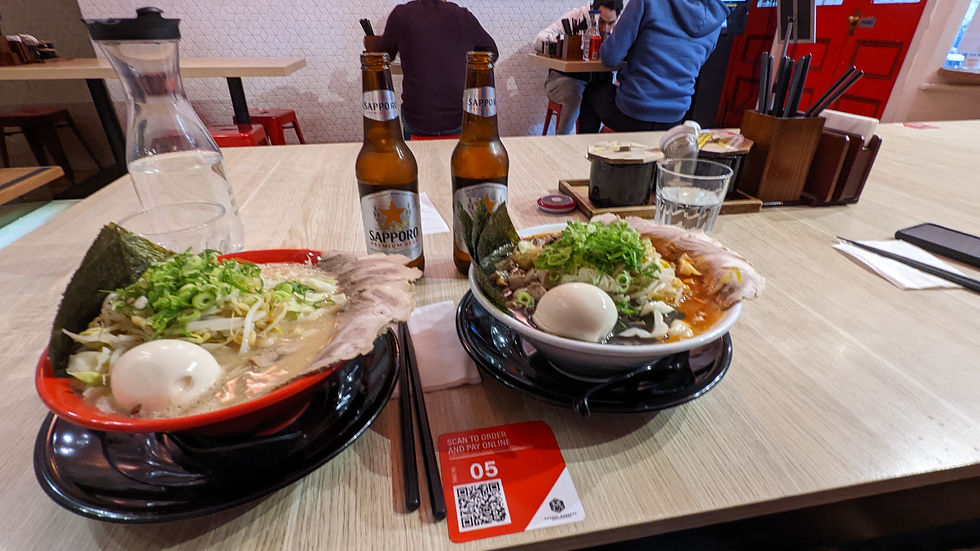








Coffee!
Melbourne coffee culture is internationally recognized as being one of the most innovative and vibrant coffee scenes in the world. We can see why. Brought to Australia by Italian immigrants in the 1950s, the coffee has a strong, rich flavor but comes in many concoctions. We can buy good roasted beans anywhere (including one that says "Roasted in Melbourne by Italians!") and get a good cup out at any of the dozens of cafes in a 10-minute radius. None of the styles come with actual cream (an American indulgence and one that I just can't seem to shake) but you can buy cream in the grocery for the home-made french press in the morning. And, they don't look at you like you are speaking Martian if you ask for decaf in the evening. Paul enjoys a long black, and when I go out, I get a cappucchino, which has a higher coffee to milk ratio than a flat white with a little chocolate sprinkled on top.



A compact footprint that is easy to traverse
It is so easy to get around Melbourne. The Central Business District (CBD) is pretty compact, criss-crossed with tram routes (free in the center of the city) and walkable. In this center, there are numerous public buildings, parks, restaurants, stores (including several shopping centers), groceries, hotels, and theaters. When you add the inner suburbs, which are available by frequent trams and buses, you have easy access to museums, universities, larger markets, larger parks (including the zoo), the Melbourne Harbour, the docklands (where the cruise ships dock) and more residential areas. Several major stations on the border of the CBD link subways and light rail to the outer suburbs. Those stations include Southern Cross Station, Flinders Station, and Melbourne Central Station. There are numerous bike paths and biking is popular (although it has become so popular, especially given the vast increase in food delivery, that it is difficult to find bikes to rent.)
To access public transit, you need a MYKI card or the MYKI app installed on your phone. You can buy a physical card at any of the stations, at 7-11 Stores (which are ubiquitous) and other stores that display a sign. Top-up machines are in the train stations, on the street at certain tram stops, and in the same stores that sell the cards. Single fare outside the free tram zone is AU$4.60 and the fare is capped at twice that per day. Rates are less if you buy daily, weekly, or monthly passes and there is a 50% discount for certain categories including children, Australian senior citizens, and international students, among others.






Diverse, welcoming people
People in Melbourne are very friendly, not hesitant to chat to strangers or offer help. They are also extremely diverse. As we walk through the streets and ride on the trams, we see so many different looking people. The populace is mixed racially and ethnically. Some wear hijab, some a turban, others a sundress or a suit. Yesterday a young woman got on our tram wearing a pink anime costume. I've seen women with pink, green, purple and orange hair and women with long natural braids. I feel completely free to wear what I want when I want and am comfortable I will fit in. With a large population of European, Indigenous, and Asian people, this is one of the places where Paul and I both feel we fit in. We hear many different languages - even the occasional U.S. accent! There is also a broad spectrum of political views, and with ranked voting smaller parties have a greater chance of success. What's remarkable to me is that this diversity is not remarkable.
Melbourne is home to people from almost 200 cultures from around the world. The original inhabitants, called First Peoples or Aboriginal Peoples in Australia, lived on the continent at least 40,000 years before European settlers, and there are several museums here that explore that history and culture. The modern city was founded by the English in 1837 under Queen Victoria. Not long after, gold was discovered, which resulted in massive building (hence many Victorian-era structures which still exist in the city) and a rush of Chinese immigrants to work in the gold fields. Many people of Chinese descent stayed in Victoria and today are a vibrant and successful part of the community. After WW II, there was a wave of immigration from southern Europe, especially Italy, Greece, and Turkey. In the 1970s, many immigrated from Vietnam and Cambodia. More recent arrivals are from China, India, Malaysia, and Indonesia. You can see the diverse population all around the streets of Melbourne. It is in the languages, the restaurants and the stores.
The Immigration Museum in Melbourne tells the history of these migrations, and the racism that many of these populations have faced. Disparities remain against people of color and others, but activists work to address inequities. Melbourne was a center in the 1960s for indigenous rights, in the 1970s for women's rights, in the 1980s for gay rights, and more recently, immigrant rights. The State of Victoria has a Charter of Human Rights and Responsibilities addressing the cultural rights of the First Peoples in addition to more recent populations. There have been recent conversations about increasing the representation of women and people of color in public sculptures in Victoria. Below you can see a sculpture of 2 early indigenous activists, Pastor Sir Douglas and Lady Gladys Nicholls, on the grounds of Victoria Parliament.



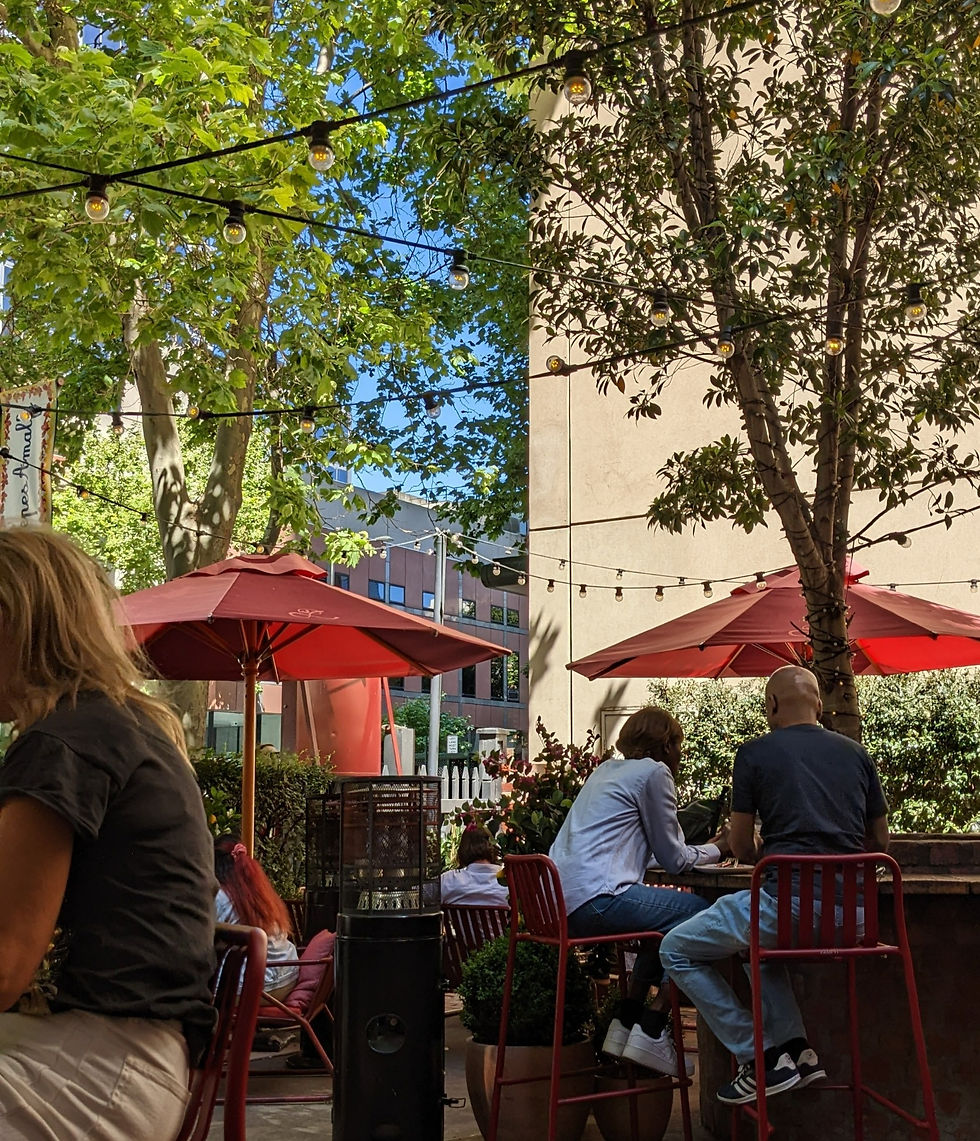





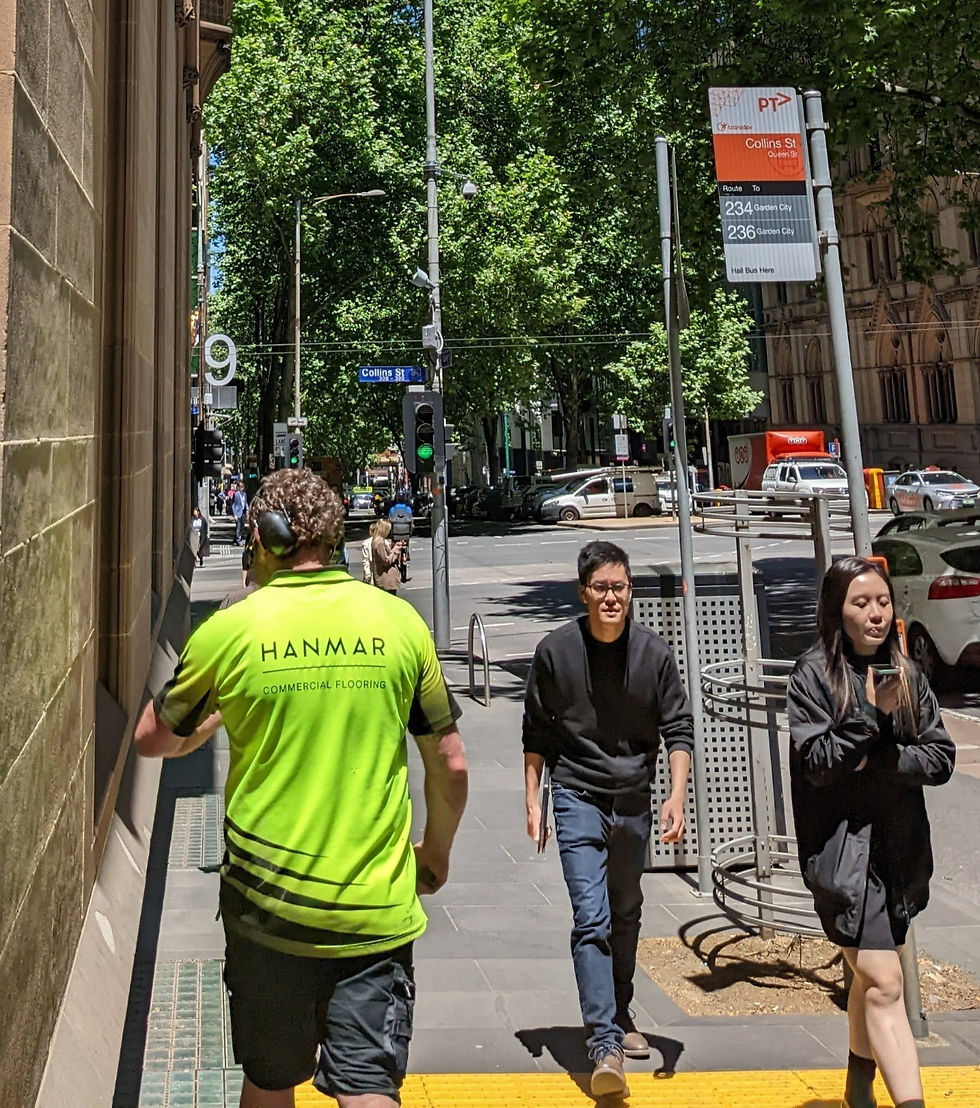


Charm
Tucked into this modern city are whimsical elements that charm us. The CDB is laid out in a Victorian-era scheme of main streets, "little" streets, and lanes. In the 1800s, these smaller streets had service functions and trades people to support the main commercial streets. Now, they create a charming burrough of small venues, often filled with street art (although less than pre-Pandemic, it seems to us). Victorian-era buildings, large and small, permeate. Also downtown are Victorian-era arcades with small shops and mechanical clocks. In Fitzroy Park, there is a little Tudor Village, created by 77-year old pensioner Edward Wilson of London, England to honor Melbourne's contributions of food during WWII. It was opened in 1948. Across the path, a fairy tree.



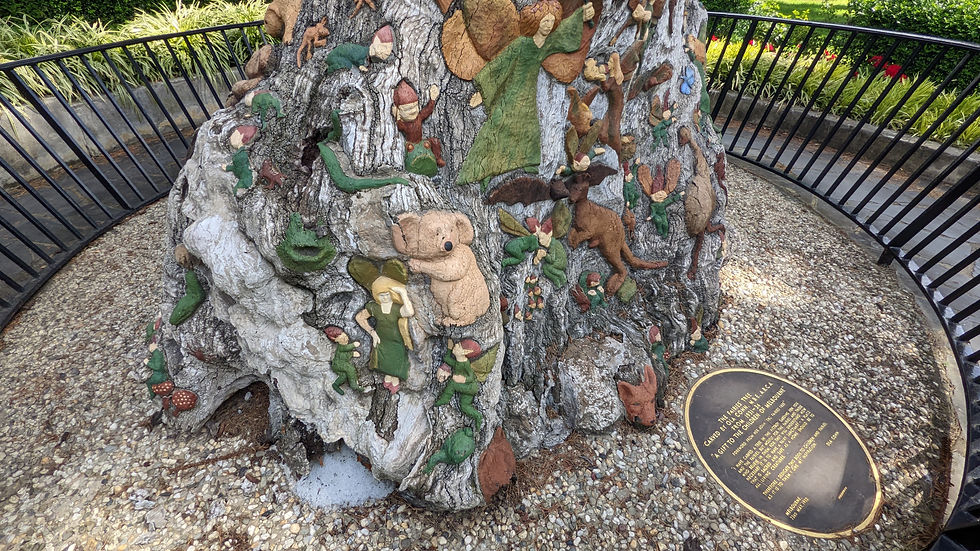








The markets
We love the 3 main markets in Melbourne. Each one has something the other two don't have. Each one is easy to access on public transit.
Victoria Market, in the heart of the CBD (Central Business District) is the largest market in the Southern Hemisphere. Catering to large buyers, it is open 6am-3pm Tuesday, Thursday, & Friday; 6am-4pm Saturday, 9am-4pm Sunday and closed Wednesdays. During the summer, there is a night market Wednesdays from 5pm-10pm. The "newest" of the 3 main markets in Melbourne, Queen Victoria Market opened in 1878. Post-Pandemic, we have noticed the most difference in this market. One of the large halls is undergoing renovation, with about a third of the previous wares in the outdoor venues. There is still plenty to see and buy. Covered halls in the old brick buildings house dairy (so many cheeses!), delis (olives, dips, sausages, stuffed peppers and dolmades), bread, wine, meat, and fish. Just outside the brick buildings there are wonderful Italian coffee shops. There is one covered shed with organic fruits and vegetables, and another with a wide array of fruits, vegetables, spices, nuts, wares (clothing, souvenirs) and food to go. It is the closest to the CBD (Central Business District), at the end of the free tram zone and a stop on all the trams down Elizabeth Street.
The South Melbourne Market offers great croissants, hand-made pasta and sauces, quiches, coffee, and fresh oysters. Opened in 1867, it is one year older than Victoria and a few years younger than the Prahran Market, it claims to be the oldest continuing market in Melbourne. It has a slightly more modern vibe, in part due to a 1981 fire destroying two original buildings. It has a more compact footprint, making it easier to traverse. It is open Wednesday, Friday, & Sunday from 8am to 4pm and Saturday 8am-5pm. The 96 tram to St. Kilda beach takes you right there, at the Central Melbourne stop. When we lived on the Yarra River across from the Casino, it was a nice 20-minute walk.
The third, and oldest, market is the Prahan Market. It was established in 1864, but moved into its current location on Commercial Street in 1891. I really like their vegetable selections, which are a bit easier to browse and always fresh. Whilst the vegetable vendors in Victoria are in full vendor mode (shouts of get your fresh pumpkin, $10 per kilo!" and so on), the ones in Prahan are more personal. On one outing, each of 3 vegetable vendors assisted me in choosing small onions for my Thanksgiving meal. They have a great nut shop, a good spice shop, a nice home-made pasta and sauce shop, a wine store and a deli. There is live music Saturdays and Sundays, which seems to tend toward jazz and is very nicely located in a small food court. Prahan is open 7am-5pm Tuesday, Thursday, Friday, & Saturday, & 10am-3pm Sunday. To get there, take the 72 tram (Camberwell) from Federation Square on Swanston Street.







Events
Melbourne is a world-class city with world-class entertainment, sporting events, and festivals. You can book tickets to ballet, opera, musicals, theater, and comedy. When we were here in March and April, we always went to the Melbourne Food and Wine Festival and sometimes attended Comedy Festival events. In February, we attended the Opera at the Market. Those events are bouncing back after the Pandemic. We're not sports people, but we can appreciate that this is home to the Australian Open Tennis tournament, the F1 Australian Grand Prix, and a vibrant footy (Australian rules football) league.
Less crowded, fewer lines
One of the things we notice the most in both Australia and New Zealand, compared to living in the U.S., is a more relaxing, less frenetic pace. We're not sure if it's lower population density or something else, but we get into places sooner and wait in line less here. Even when Victoria Market seems swamped, we never have to wait more than a few minutes in line. While the city is vibrant (a bit less crowded post-Pandemic, though we've seen an uptick as Christmas approaches and everyone seems to want to go into the city), we can book a table at the most popular restaurants on the day, at prime times within a couple of days. We've never had a problem booking a ticket to events, and when we attended festivals we never had to wait in line more than 10 minutes.
Art
Melbourne is a place where art finds expression. The National Gallery of Victoria, conveniently located in two spots downtown (European and Indigenous), offer wonderful collections. There are sculptures throughout the city. People draw art in chalk on the sidewalk (sometimes huge pieces) and paint the laneways. There are many beautiful and carefully maintained parks sprinkled throughout the city. Melbourne is a visually pleasing place to be.





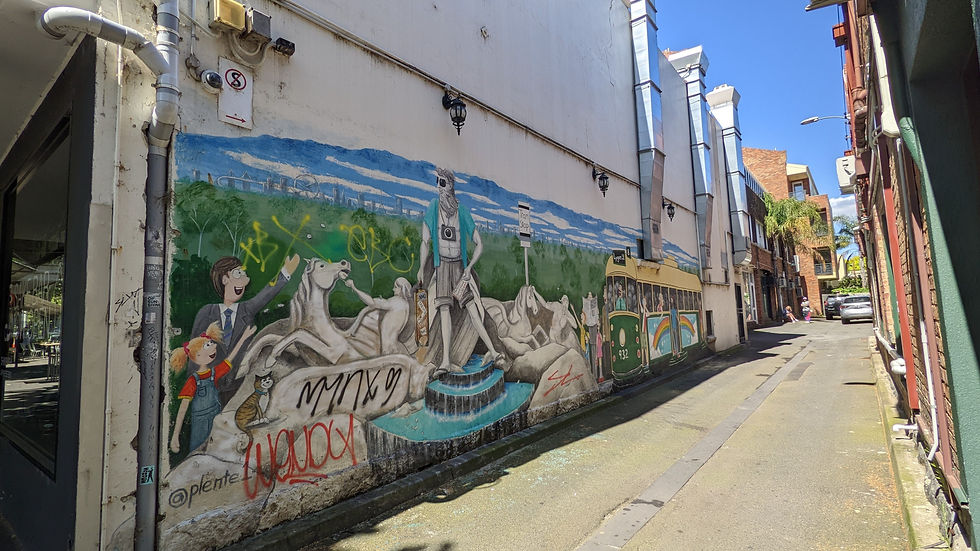


The perfect blend of old and new
We love walking around a world-class, modern city with old, preserved features. We think the old and new are perfectly blended.


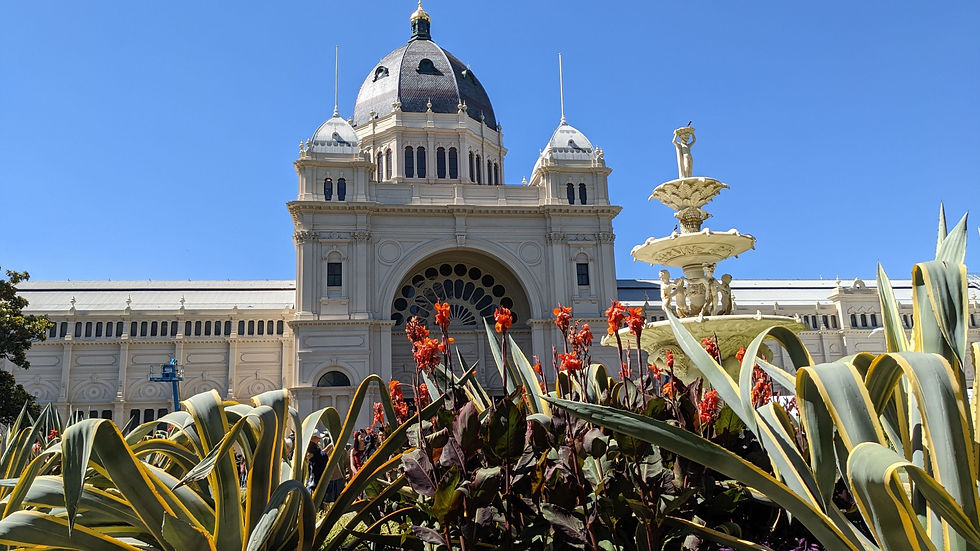


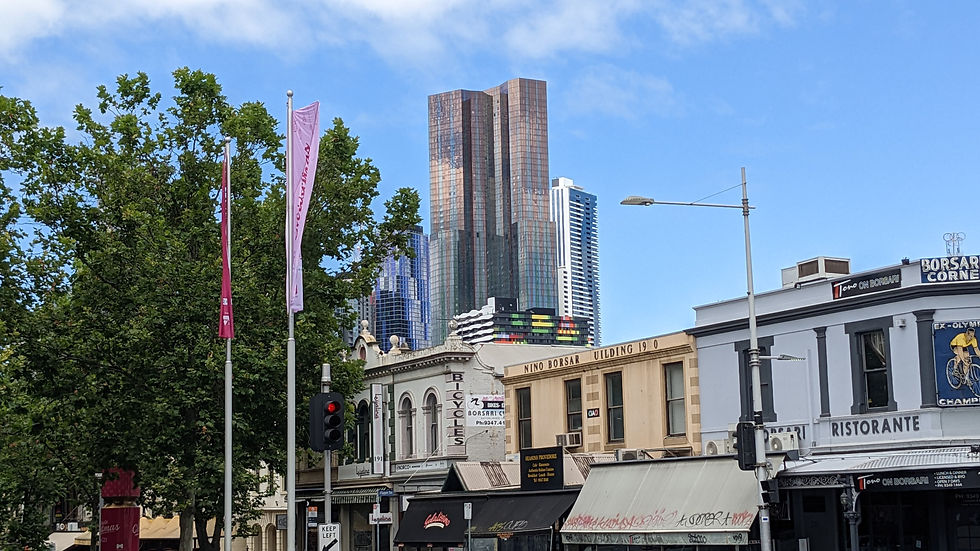


What is not on the list
There are a few downsides to living in Melbourne. The time difference from east coast USA is a bit of a problem. It's hard to schedule meetings, or contact a business, or talk to family and friends. Paul trades on the market and he has to either stay up really late or get up really early. Melbourne is also not the most affordable city to live in, although we came at a good time. The exchange rate between AU and US dollars has been very favorable to us, and post-Pandemic we got a good deal on housing. The weather here can be unpredictable. A favorite saying of the people who live here is, "Melbourne, four seasons in one day!" and we can see why. It might be 50F in the morning and 80F in the afternoon with rain then dry then rain again. If your activities are weather-dependent, you might have a hard time. On the other hand, it is not typically blisteringly hot most summer days nor freezing cold most winter days, although it can get to be both on occasion. Another downside is visas for people 55 and older. Australia (like NZ) prohibits residence visas for people our age unless they have a well-paying, full-time job and even then, only for 5 years, renewable 5 years). We don't understand why these countries would not welcome our dollars and our enthusiasm, but we can only stay 6 months in a year, 3 months at a time.
But, on balance, we are thrilled to be living in Melbourne again, if only for a few months!




Enjoy your stay. Immigration museum! So neat!